Let me tell you how this purple twist happened. I had leftover ube sitting in my freezer after making halaya, and curiosity got the better of me. Like many, I was skeptical about swapping chocolate for ube in champorado. Would bland rice and subtle ube even work together?
But after grating fresh ube (none of that bottled stuff) and simmering it with coconut milk and palm sugar, I discovered something surprisingly delicious. It's like three beloved Filipino dishes - biko, ube halaya, and champorado - had a delicious love child. If you love any of those dishes, you need to try this version.
Jump to:
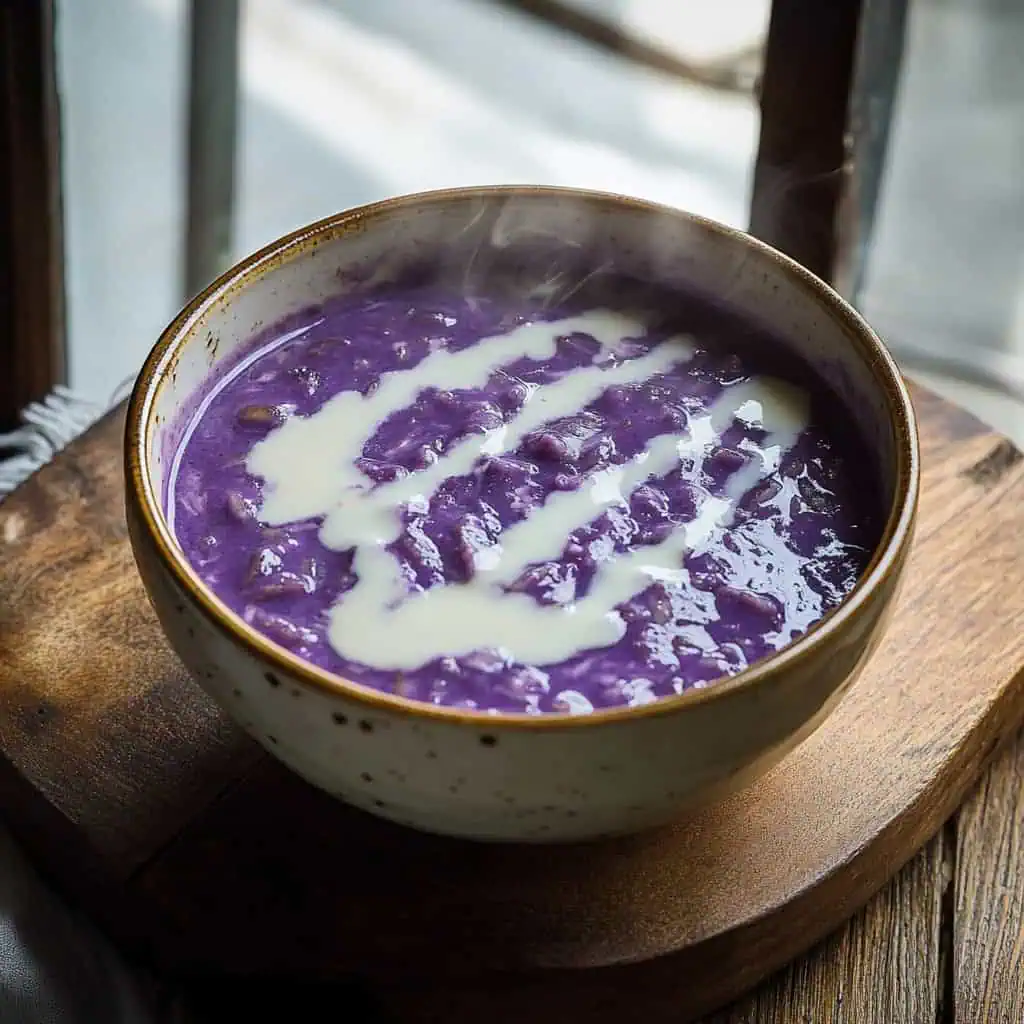
Why You'll Love This Recipe
- Uses real ube for authentic texture and flavor
- Creamy, comforting consistency perfect for breakfast
- Beautiful purple color that's Instagram-worthy
- Versatile - can be served sweet or paired with savory sides
- Made with simple, accessible ingredients
- Perfect balance of coconut and ube flavors
Ingredients
This ube champorado recipe carefully balances traditional Filipino flavors and cooking techniques. Glutinous rice provides the signature sticky texture that makes champorado comforting and filling. Fresh purple yam (ube) delivers natural color and earthy sweetness that processed alternatives can't match.
Coconut milk adds rich creaminess while complementing the ube's subtle flavor profile. Palm sugar contributes caramel notes that refined sugar lacks, creating depth in each spoonful. The small amount of salt enhances all other flavors without making the dish salty. Ube flavoring boosts both color and taste, especially important when using ube varieties that might be less vibrant.
Together, these ingredients create a harmonious blend that honors the dish's heritage while offering a modern twist on classic champorado.
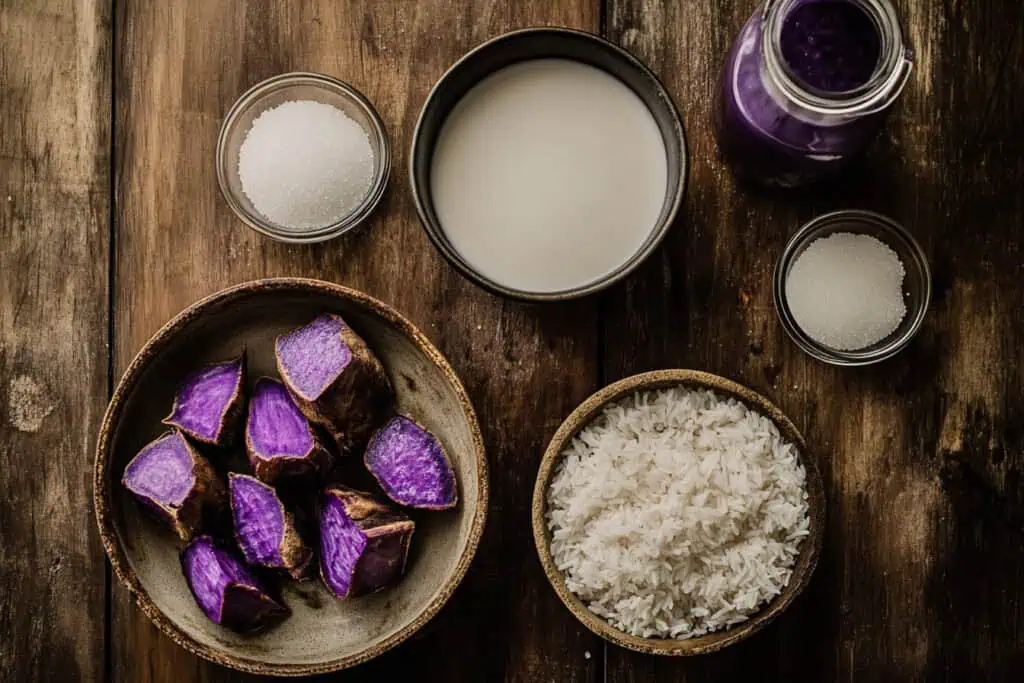
- 1 cup glutinous rice (malagkit)
- 4½ cups water
- 1 cup coconut milk
- 50 g palm sugar or muscovado sugar
- 1 cup grated fresh or frozen ube (purple yam)
- 2 teaspoon ube flavoring
- 1 teaspoon salt
For Serving:
- Evaporated milk or powdered milk
- Additional muscovado sugar
- Optional: Dried salted fish (tuyo, danggit, or dilis)
Equipment Needed
- Large Heavy-Bottom Pot (Kaldero) - Ensures even heating and prevents rice from burning at the bottom, essential for achieving the perfect creamy consistency.
- Wooden Spoon (Sandok) - Allows gentle stirring without breaking the rice grains; metal spoons can be too harsh.
- Box Grater (Kudkuran) - Essential for properly grating fresh ube to the right consistency for even cooking and distribution.
- Measuring Cups and Spoons - For precise measurements which affect the final texture and taste.
- Ladle (Sandok) - For serving the champorado while maintaining its creamy texture.
- Medium Bowl - For soaking the glutinous rice before cooking.
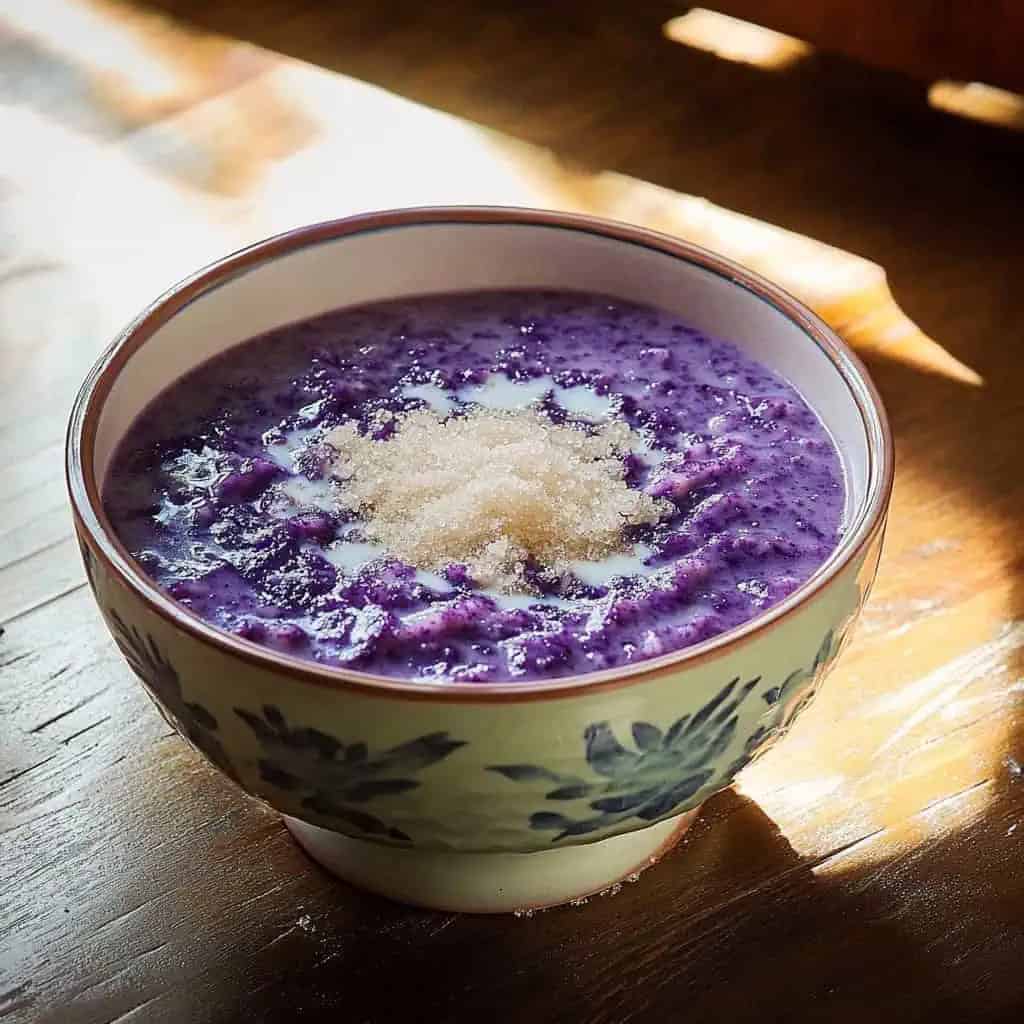
How To Make
- First, soak 1 cup glutinous rice in water for 30 minutes, then drain completely.
- While the rice soaks, grate your fresh ube using a box grater until you have 1 cup.
- Put your soaked rice in a heavy pot with 4½ cups water. Turn heat to high and bring to a full boil.
- Once boiling, turn heat to low and simmer for 12 minutes. Stir often from the bottom with a wooden spoon so the rice doesn't stick.
- Pour in 1 cup coconut milk, add 50g palm sugar, your grated ube, 2 teaspoons ube flavoring, and 1 teaspoon salt. Mix everything together well.
- Keep cooking on low heat for another 10 minutes, stirring regularly, until the rice is very soft and creamy. If it gets too thick, add a little warm water until it flows nicely.
- Turn off the heat and let it rest for 2-3 minutes. It will get a bit thicker as it sits.
- Serve hot in bowls. Add evaporated milk and sprinkle with muscovado sugar to taste. If you'd like it the traditional way, serve with dried salted fish on the side.

Tips from Lola's Kitchen
- Pre-soaking is essential - Don't skip soaking the glutinous rice as it dramatically improves the cooking process and final texture.
- Use fresh ube whenever possible - The flavor difference is remarkable compared to processed options.
- Bottom-stirring technique - Use a figure-eight motion when stirring from the bottom to prevent sticking without breaking rice grains.
- Color enhancement - If your ube isn't giving enough vibrant color, a tiny drop of purple food coloring can help, though ube flavoring usually adds sufficient color.
- Taste as you go - The sweetness level can be adjusted throughout cooking to suit your preference.
- Perfect consistency test - When your wooden spoon stands upright for a moment before slowly falling, the thickness is just right.
Substitutions
- Fresh ube → Frozen grated ube (thaw first) or ube halaya (reduce to ½ cup and use less sugar)
- Palm sugar → Brown sugar or coconut sugar (maintains caramel notes) or white sugar (for a cleaner taste)
- Coconut milk → Evaporated milk or half-and-half (changes flavor profile but works in a pinch)
- Glutinous rice → Japanese short-grain rice (similar sticky quality) or regular white rice (texture will be less sticky)
- Ube flavoring → Vanilla extract with additional grated ube (less vibrant color but more natural flavor)
Troubleshooting
- Too thick? Add warm water or coconut milk 2 tablespoons at a time while stirring until desired consistency is reached.
- Too thin? Continue cooking uncovered, stirring frequently. The mixture will thicken as moisture evaporates and as it cools.
- Grainy texture? Your rice likely needs more cooking time. Continue simmering on low heat, stirring frequently until rice grains fully soften.
- Rice sticking to pot? Lower heat immediately and add a splash of water or coconut milk while gently scraping the bottom.
- Not purple enough? Add a bit more ube flavoring or ensure you're using fresh, vibrant purple ube rather than older tubers.
Storage & Reheating
- Refrigeration: Store in an airtight container for up to 3 days. The champorado will thicken significantly when cold.
- Reheating on stovetop: Transfer to a pot, add 2-4 tablespoons of water or milk per cup of champorado, and heat on low while stirring constantly.
- Microwave reheating: Place in a microwave-safe bowl, add liquid as above, cover loosely, and heat in 30-second intervals, stirring between each until hot.
- Freezing is not recommended as the texture of the rice degrades upon thawing.
- Portion before storing for easier reheating of single servings without affecting the entire batch.
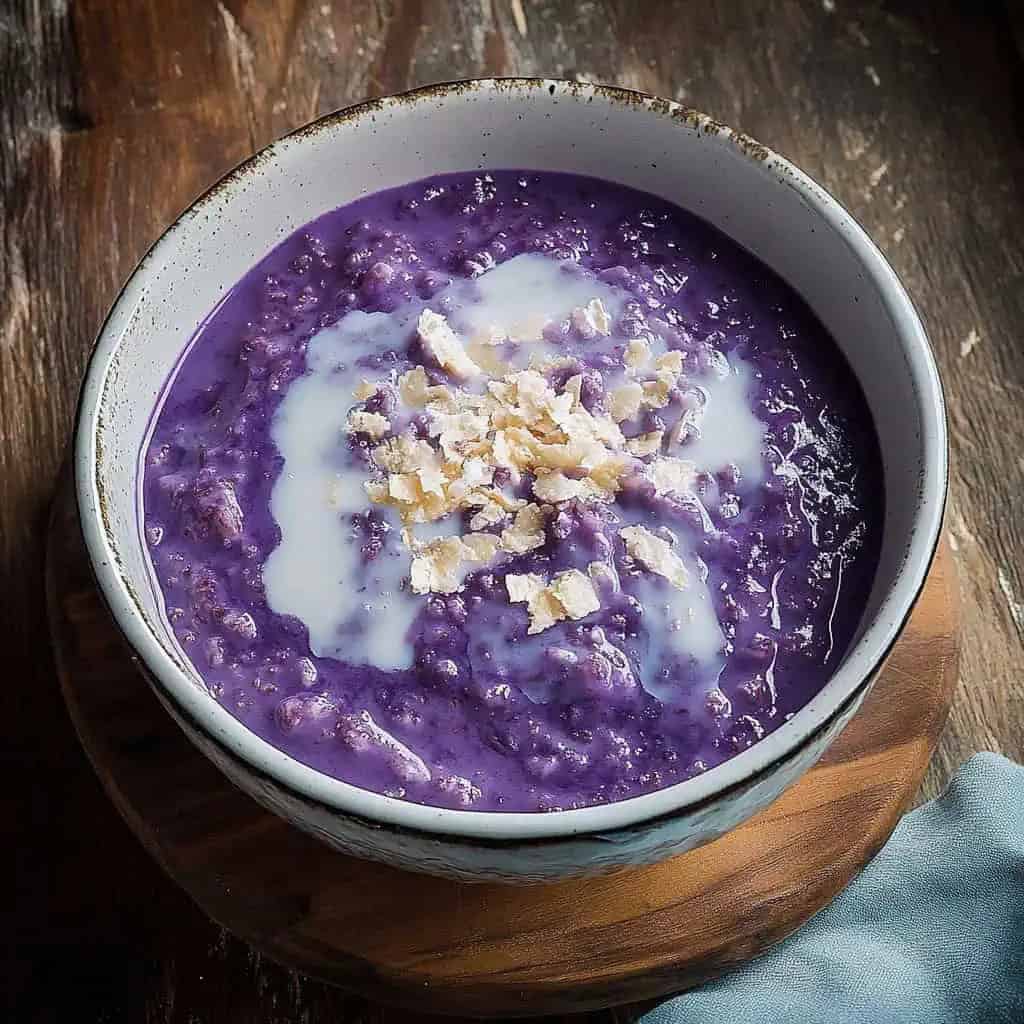
FAQ
Can I use ube powder instead of fresh ube?
Yes, but reduce to ⅓ cup and add more liquid as the powder absorbs moisture.
Why is my champorado not purple enough?
Fresh ube color varies naturally. Factors include the ube variety, age, and cooking time. Add ube flavoring for deeper color.
Can I make this with regular white rice?
Yes, but it won't be as sticky and creamy. Increase cooking time by about 5-7 minutes.
Is this dish gluten-free?
Yes, when using pure glutinous rice (which despite its name contains no gluten) and checking that your ube flavoring has no gluten-containing additives.
Can I make this in a rice cooker?
Yes! Use the porridge setting if available, adding all ingredients except coconut milk. Add coconut milk after the first cooking cycle and continue on warm setting for 10 minutes, stirring occasionally.
Why serve it with dried fish?
The contrast between sweet porridge and salty fish is a beloved Filipino flavor combination that balances the dish perfectly.
How do I know when it's perfectly done? The rice should be very tender with no hard centers, and the porridge should coat the back of a spoon while still flowing slowly when tilted.
Related
Looking for other recipes like this? Try these:
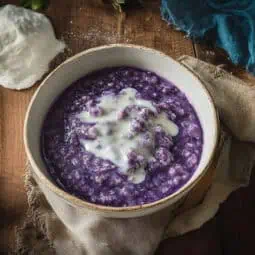
Ube Champorado (Purple Yam Rice Porridge)
Equipment
- Large Heavy-Bottom Pot (Kaldero) Ensures even heating and prevents burning
- Wooden spoon (sandok) For gentle stirring without breaking rice
- Box grater (Kudkuran) For grating fresh ube
- Measuring cups and spoons (Panukat) For accurate portions
- Ladle - sandok For serving
Ingredients
For the Champorado
- 1 cup glutinous rice malagkit
- 4½ cups water tubig
- 1 cup coconut milk gata
- 50 g palm sugar or muscovado sugar panocha
- 1 cup grated fresh or frozen ube purple yam
- 2 teaspoon ube flavoring pampalasa ng ube
- 1 teaspoon salt asin
For Serving
- Evaporated milk or powdered milk gatas
- Additional muscovado sugar asukal na pula
- Optional: Dried salted fish tuyo, danggit, or dilis
Instructions
- First, soak 1 cup glutinous rice in water for 30 minutes, then drain completely.
- While the rice soaks, grate your fresh ube using a box grater until you have 1 cup.
- Put your soaked rice in a heavy pot with 4½ cups water. Turn heat to high and bring to a full boil.
- Once boiling, turn heat to low and simmer for 12 minutes. Stir often from the bottom with a wooden spoon so the rice doesn't stick.
- Pour in 1 cup coconut milk, add 50g palm sugar, your grated ube, 2 teaspoons ube flavoring, and 1 teaspoon salt. Mix everything together well.
- Keep cooking on low heat for another 10 minutes, stirring regularly, until the rice is very soft and creamy. If it gets too thick, add a little warm water until it flows nicely.
- Turn off the heat and let it rest for 2-3 minutes. It will get a bit thicker as it sits.
- Serve hot in bowls. Add evaporated milk and sprinkle with muscovado sugar to taste. If you'd like it the traditional way, serve with dried salted fish on the side.
- Best enjoyed right away while it's hot and creamy.
Tips from Lola's Kitchen
- Soak glutinous rice for 30 minutes before cooking for faster, more even cooking
- Stir from the bottom to prevent rice from sticking
- Add coconut milk gradually to control consistency
- Fresh ube should be firm and violet-colored when cut
- Toast dried fish separately until crispy before serving
Nutrition
The Story Behind Ube Champorado
Long before morning coffee became a ritual, Filipinos started their days with champorado, a chocolate rice porridge that traces its roots to Mexican champurrado - a warm chocolate drink brought by Spanish galleon traders. But in recent years, innovative home cooks and chefs have been reimagining this comfort food classic with distinctly Filipino flavors.
Enter ube champorado - a brilliant fusion that replaces traditional cocoa with purple yam, transforming the breakfast staple into a stunning violet creation. This adaptation emerged during the global ube trend of the 2010s, when social media discovered the photogenic purple tuber that Filipinos had cherished for generations. Unlike the original chocolate version, ube champorado draws from two beloved Filipino desserts: the sticky rice treat biko and the creamy purple yam jam ube halaya.
What makes this version special is its use of real grated ube rather than processed ube flavoring or halaya. When combined with glutinous rice and coconut milk, the fresh purple yam creates a distinctive grainy texture that's essential to authentic Filipino ube dishes. The addition of palm sugar (panocha) deepens the flavor profile, while maintaining the traditional practice of serving with salty dried fish - a sweet-savory combination that exemplifies Filipino breakfast cuisine.
This modern interpretation preserves the soul of traditional champorado while celebrating ube's rising status in global cuisine. Whether enjoyed during breakfast (almusal) or afternoon snack (merienda), ube champorado represents the evolution of Filipino food culture - honoring heritage while embracing innovation.
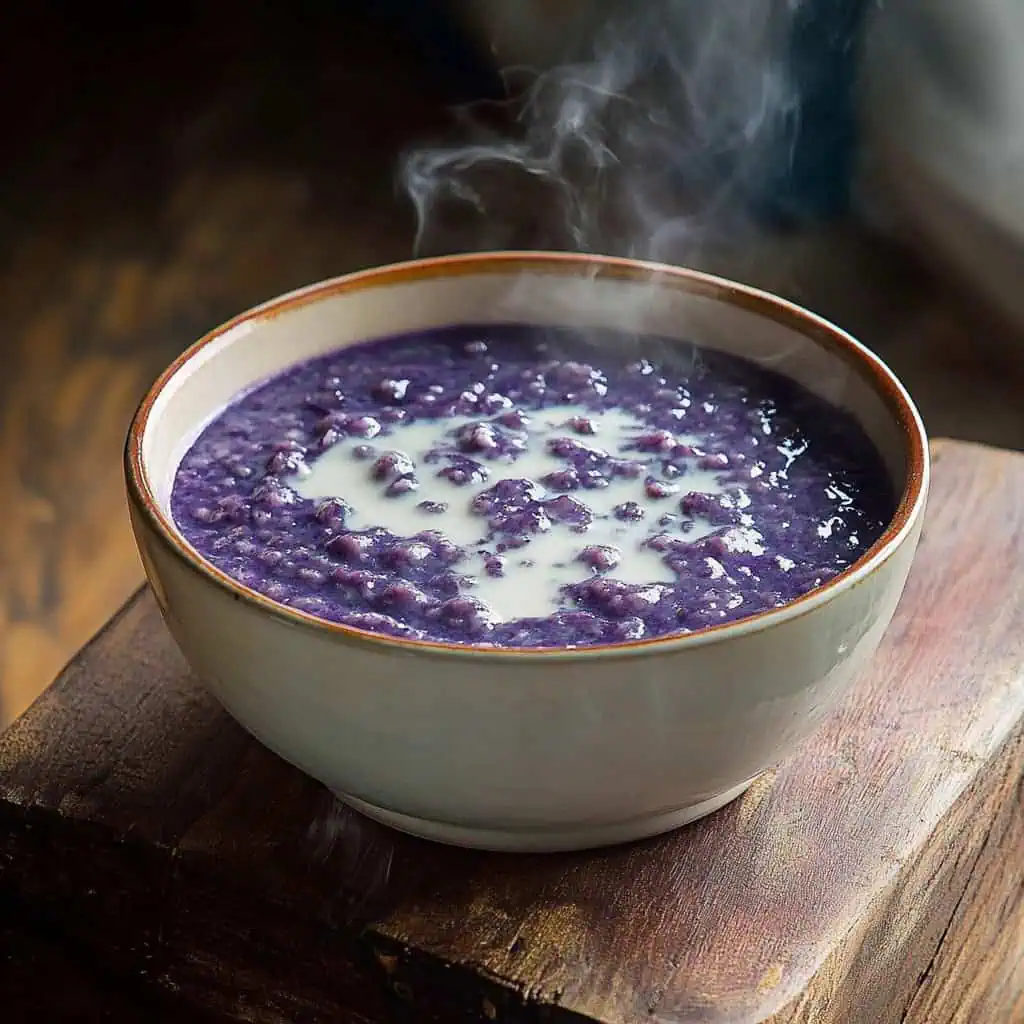







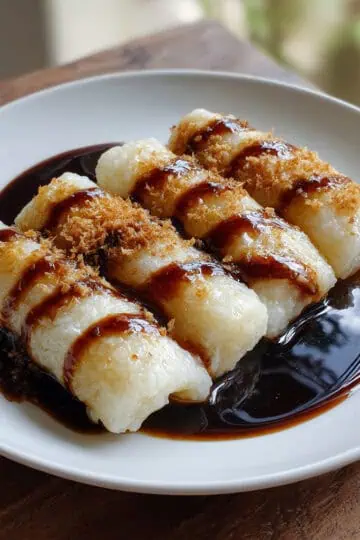
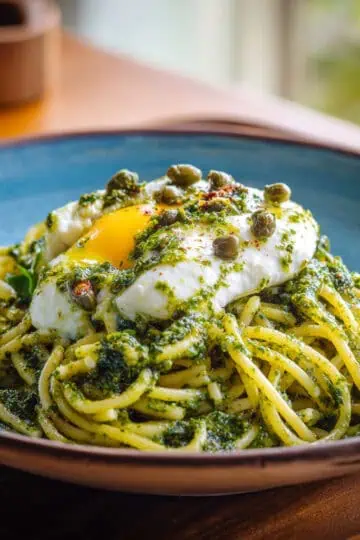
Comments
No Comments